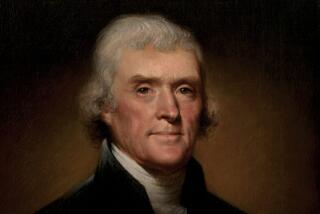The Joy of Inheritance : THE FOUNDING FORTUNES A New Anatomy of the Corporate-Rich Families in America <i> by Michael Patrick Allen (Truman Talley/Dutton: $22.50; 480 pp.) </i>
- Share via
This readable, incisive and important book examines a slice of the economic elite, the 1% of Americans who own more than half of all stocks and bonds and who wield influence far beyond their numbers over the choices our democracy makes.
The rich have always been with us, but unlike the poor, they are seldom studied. Other than society-page fluff and tales of corporate captains courageous, surprisingly little is known about wealthy Americans and especially about the bulk of the rich, who got their money the old fashioned way: They inherited it.
Author Michael Patrick Allen, a Washington State University sociology professor, examines how the richest of the rich got their money, what it takes to keep it and how the tax system favors wealth.
Most Americans aspire to have money and dream of millions of greenbacks. The wealthy know better. They hold their assets in more durable paper: stocks, bonds, partnerships, land titles.
Everyone understands the paycheck (or dividend, interest or welfare check), but few comprehend wealth, perhaps explaining why our democracy taxes incomes more effectively than wealth.
Income flows like a watercourse--an uncertain creek for many, a steady stream for most and a mighty river for a very few. The tax man simply dips his bucket into that flow and takes his measure.
But wealth is like a reservoir. Assets accumulate behind paper dams constructed from trusts, depreciation schedules and fictional investment losses carefully engineered by lawyers, accountants and bankers. These highly paid experts help the rich shape their wealth to preserve capital or obtain maximum growth, while at the same time making the reservoir appear small on the surface, which the tax man can easily observe. In this way, the very rich are only more sophisticated than the working stiff, who presents his finances one way to a banker when seeking a loan and another to the tax man come April 15.
The subtitle of Allen’s book refers to the “corporate rich” because it is through the modern legal concept of corporations that the bulk of wealth in the United States was created or, in some cases, merely accumulated.
Generally we tax great wealth only when it is transferred, particularly at the wealth holder’s death. Yet when the wealth holder dies, when his or her financial dam suddenly bursts, the government agencies charged with collecting death taxes are so understaffed that they often fail to notice all but the most blatant attempts to understate the size of estates.
To many whose diligence has brought them some assets, especially petty merchants, the idea of taxing wealth seems an outrage. But Americans have always taxed some forms of wealth. Real estate property taxes, after all, are a form of annual assets tax. But we don’t impose similar taxes on stocks and bonds.
Allen’s book makes one dubious argument. “Conventional wisdom,” he asserts, holds that “wealthy capitalist families have been driven to the brink of extinction” by death taxes with nominally progressive rates. Could anyone believe that assertion when the fortunes of the Forbes 400 wealthiest individuals have ballooned spectacularly in an almost stagnant economy?
Allen gives readers an easy stroll through the potentially bewildering labyrinth of wealth and taxes. He explains how the rich shift the forms in which they hold wealth to avoid taxes that could eat away at principal. Property can be owned outright, but assets can also be put in a trust where one generation effectively controls the wealth, the second generation receives the income from it and a third eventually will inherit the property. Variations of this concept abound.
The tax savings, which our liberal wealth tax laws grant the rich by allowing them to manipulate forms of ownership, are enormous. Allen reports on a trust that Charles S. Mott, the early General Motors tycoon, created for his fourth wife and their children.
Mott put more than $5 million in a trust for them and paid a gift tax Allen estimates at $1.5 million. Gift taxes are designed to make sure the wealthy do not escape estate taxes by transferring their money before death. But current law is so generous that a couple with four married children and eight grandchildren can transfer $6.4 million to them tax-free over two decades, and if done in the form of stocks whose market price understates their asset value, the real transfer can be much larger.
Thus the nominal 30% gift tax Allen assumes Mott paid seems stiff. But Allen shows how it was a bargain. When Mott died 33 years later, the stock was worth $45 million. Had Mott kept the stock until death the nominal estate tax would have been $33 million, or 22 times what he paid, and his heirs would have received just $12 million. This ability to hold wealth in many forms and to shift among these forms is at the core of why wealth is lightly taxed in America, even when it passes from one generation to another.
Allen offers his book as a successor to Ferdinand Lundberg’s “The Rich and the Super Rich” (Lyle Stuart), a ‘60s treasure of insights that stayed on the best-seller lists for more than a year despite its dry writing. “The Founding Fortunes” is an important addition to the small body of significant books critically examining the American rich, including Lundberg’s “Sixty Families,” which strongly influenced the New Deal makers; C. Wright Mills’ “The Power Elite,” Teresa Odendahl’s “America’s Wealthy and the Future of Foundations,” William Domhoff’s “Who Rules America?” and Waldemar Nielsen’s “The Big Foundations” and “The Golden Donors.”
Like all but Odendahl’s book, “The Founding Fortunes” suffers from being mostly library research. Allen is a prodigious fact gatherer, but the people he mentions are more names than characters. His 83-page appendix, with thumbnail sketches of 160 super-rich families, gives some life to his text, but still there is little human drama despite fascinating facts that suggest myriad intrigues that could be crafted into powerful and informative nonfiction appealing to a much broader audience.
More to Read
Sign up for our Book Club newsletter
Get the latest news, events and more from the Los Angeles Times Book Club, and help us get L.A. reading and talking.
You may occasionally receive promotional content from the Los Angeles Times.










